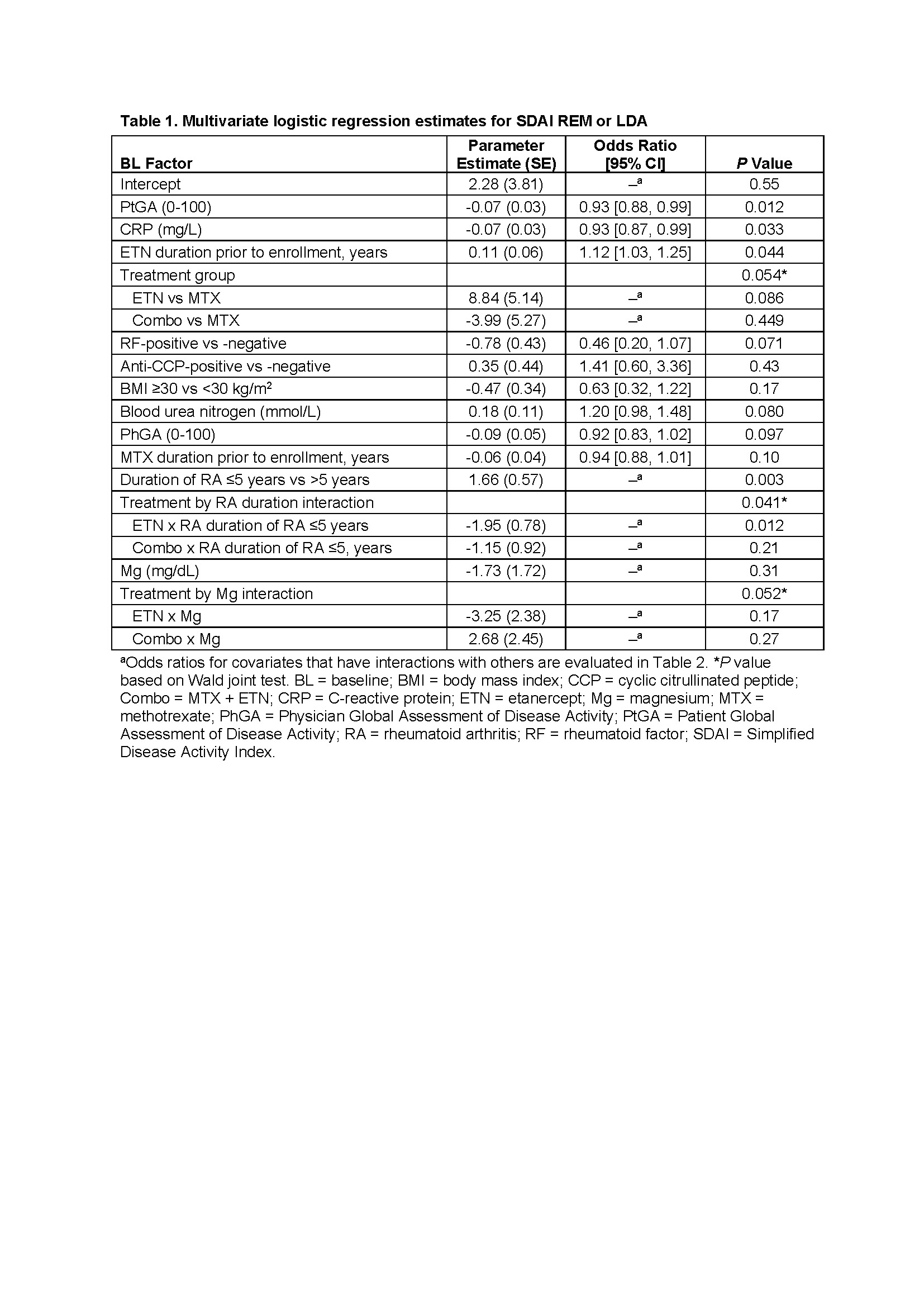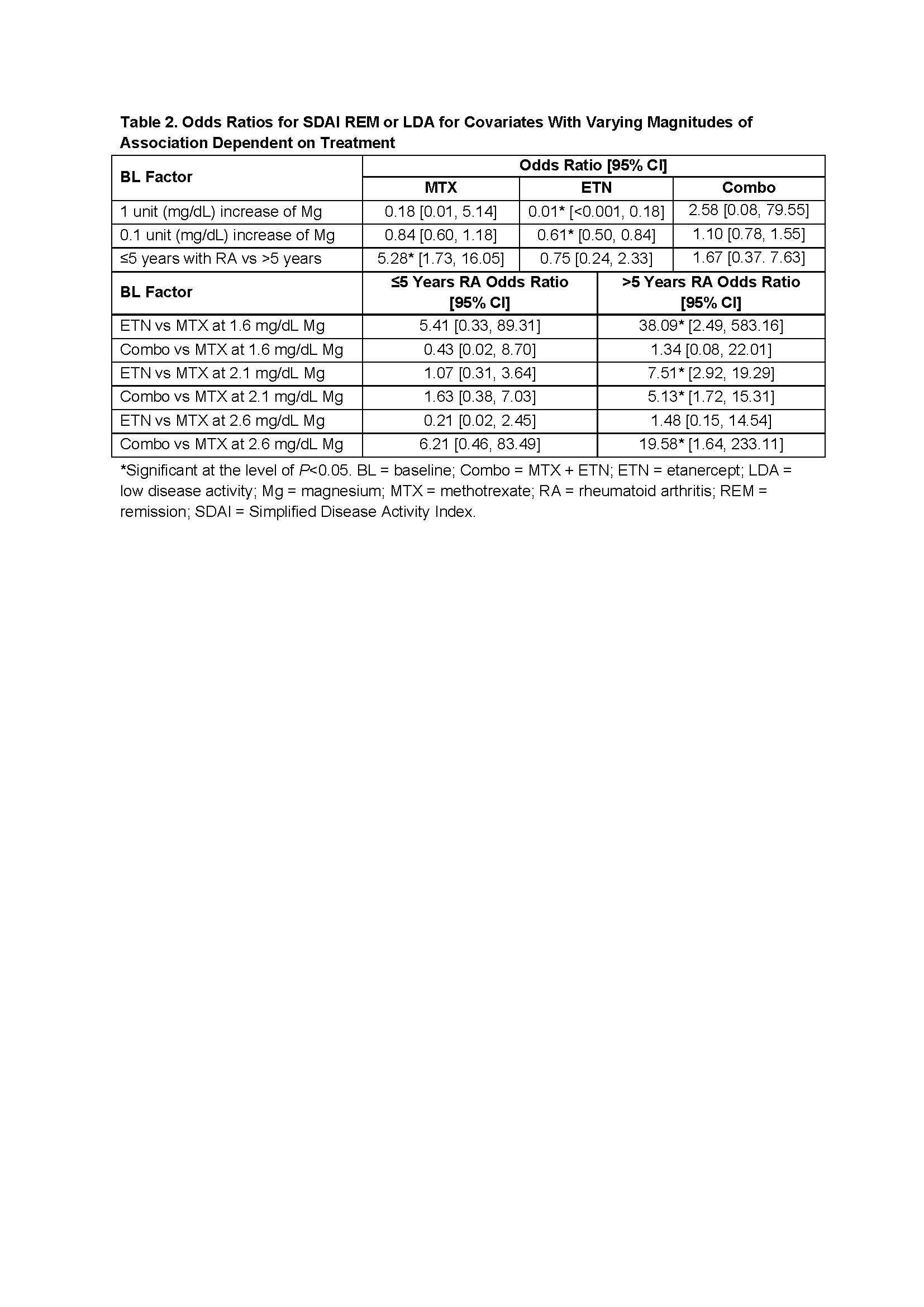Session Information
Date: Monday, November 8, 2021
Title: RA – Treatments Poster II: PROs, Biomarkers, & Systemic Inflammation (1223–1256)
Session Type: Poster Session C
Session Time: 8:30AM-10:30AM
Background/Purpose: According to ACR and EULAR recommendations, patients with rheumatoid arthritis (RA) who persist in remission (REM) should consider tapering RA therapy. Identification of clinical factors that are associated with a patient remaining in REM following tapering is of value. Since low disease activity (LDA) is an acceptable disease state, we utilized multivariate logistic regression to assess baseline (BL) factors associated with remaining in REM or LDA during methotrexate (MTX) monotherapy, etanercept (ETN) monotherapy, or combination therapy (combo).
Methods: SEAM-RA was a phase 3, multicenter, randomized withdrawal, double-blind, controlled study in patients with RA on MTX + ETN (combo) who had very good disease control for 6 months prior to study entry. If REM (primary endpoint, Simplified Disease Activity Index [SDAI] ≤3.3) was sustained through a 24-week open-label period, patients then entered a 48-week, double-blind period and were randomized 2:2:1 to receive MTX monotherapy, ETN monotherapy, or combo therapy. We evaluated >60 covariates in a step-wise approach to identify BL factors associated with REM or LDA at the end of 48 weeks without disease-worsening. A P value of ≤0.25 was required to enter the regression model, and covariates remained in the multivariate model if P ≤ 0.15 or if commonly of clinical interest in studying RA. Interaction terms for all covariates per treatment arm were also assessed during variable selection to consider varying magnitudes of association by treatment arm. Score selection with best subset was used to confirm the model.
Results: In total, 253 patients with RA were included in the analysis. BL rheumatoid factor (RF) and Patient Global Assessment of Disease Activity (PtGA) showed strong association with SDAI REM or LDA (Table 1). After adjusting for other factors, patients with a 1-point higher PtGA (0-100 scale) at BL were 0.93 times more likely to maintain SDAI REM/LDA at Week 48. RF-positive patients were less than half as likely (OR, 0.46) as RF-negative patients to remain in REM/LDA at Week 48. Longer RA duration in the MTX arm and shorter duration of ETN treatment strongly decreased the odds of SDAI REM/LDA (Tables 1 and 2). An association was also found between lower CRP at BL and REM/LDA (Table 1). There was a trend for non-obese patients to be more likely to remain in REM than obese patients, although significance was not achieved. In addition, MTX and ETN patients with higher magnesium levels at BL had lower odds of maintaining REM/LDA, with an especially strong association within ETN monotherapy (Table 2). The area under the curve for the receiver operating characteristic of the model was 0.78.
Conclusion: These findings indicate patients with overall lower disease activity are more likely to remain in SDAI REM/LDA after tapering RA therapy. RF-negative status and lower PtGA scores in particular were strongly associated with likelihood of remaining in REM/LDA with MTX or ETN monotherapy. The role of magnesium in disease control warrants further exploration.
To cite this abstract in AMA style:
Curtis J, Emery P, Haraoui B, Kricorian G, Yen P, Collier D, Bykerk V. Low Patient Global Assessment of Disease Activity and Negative Rheumatoid Factor Are Strongly Associated with Likelihood of Maintaining Remission Following Tapering of Therapy in Patients with Rheumatoid Arthritis [abstract]. Arthritis Rheumatol. 2021; 73 (suppl 9). https://acrabstracts.org/abstract/low-patient-global-assessment-of-disease-activity-and-negative-rheumatoid-factor-are-strongly-associated-with-likelihood-of-maintaining-remission-following-tapering-of-therapy-in-patients-with-rheumat/. Accessed .« Back to ACR Convergence 2021
ACR Meeting Abstracts - https://acrabstracts.org/abstract/low-patient-global-assessment-of-disease-activity-and-negative-rheumatoid-factor-are-strongly-associated-with-likelihood-of-maintaining-remission-following-tapering-of-therapy-in-patients-with-rheumat/


